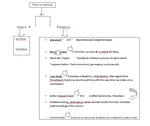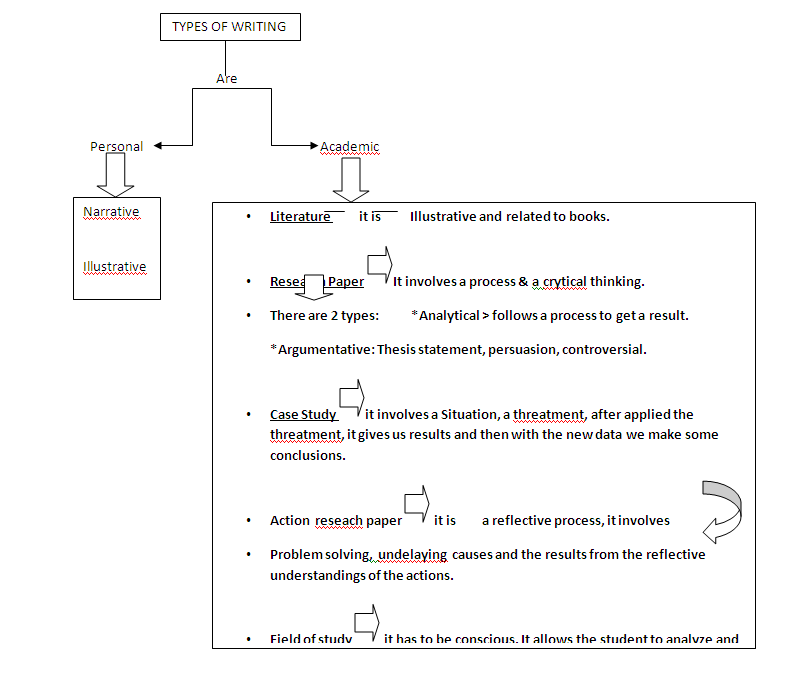User:Flakitamacias/notes
TYPES OF WRITING
ILLUSTRATIVE: It uses examples to show, explain, or prove a point.
Good Illustrative writing: *Makes a point.
- Gives detailed and specific examples to show explain or prove the point. *Gives enough examples to get the point across.
NARRATIVE: It tells a story of an event or an experience.
Good narrative writing: *Revels something of importance
*Includes all of the important events of the story.
*Begins the story to life with a detail account of what happened. *Presents events in a clear order.
DESCRIPTIVE: Creates a clear and vivid impression of the topic, translates your experience of a person, places or things into words.
Good descriptive writing: *Creates a main impression about the topic. *Uses concrete and specific details to support the main point. *Uses details that appeals to the five senses.
PROCESS ANALYSIS: Either explains how to do something or how something works. Presents the steps involved in the process.
Good process analysis writing: *Either helps readers to perform the steps or help them to understand how something works. *Presents the essential steps in a process.
*Express the steps in details.
*Presents the steps in a logical order.
CLASSIFICATION: Organizes or sorts, people or items into categories.
Good classification writing: *Make sense of a group of people or items by organizing them into categories. *Uses useful categories. *Uses a simple organizing principle. *Gives example of what fits into each category.
COMPARISON AND CONTRAST: Shows the similarities and differences among subjects, people, ideas, situation or items.
Good Comp &Cont writing: *Uses objects that have enough in common to be compared and contrasted. *Serves a purpose. *Presents several important parallel points of comparison.
CAUSE AND EFFECT: Is what made an event happened, an effect is what happens as a result of the event.
Good cause & effect writing: *Clearly distinguishes between a cause and an effect, *Does not confuse an event that happened after another one. *Gives clear and detailed examples.
ARGUMENTATIVE: Takes a position on an issue and offers reasons and supporting evidence to persuade someone.
Good argumentative writing: *Takes a strong and definite position on an issue or advises a particular action. *Gives good reasons and supporting evidence to defend the position or recommended action. *Has enthusiasm and energy from start to finish.
Anker, S(2001) Real Writing.
September 30th
PARADIGMS IN EDUACTION.
Few years ago, the education was one way directed. Students were receiving all the information; they were not able to produce. This is what we call Instruction Paradigm. “Now however, we are beginning to recognize that our dominant paradigm mistakes a means for an end”. (Barr and Tagg, 1995. P.1) People nowadays have changed their minds because they realized that in order to check if the students are learning they must make them produce language not just getting information but modifying it in order to take advantage of it.
Education is the base of society and students have to apply what they learnt sooner or later. “We now see that our mission is not instruction but rather that of producing learning with every student by whatever means work best”. (Barr and Tagg, 1995. P.1) It is important for teacher to direct their teaching in terms to make students produce their own language.
ANNOTADED BIBLIOGRAPHY.
Tokuhama-Espinosa, T. (2000) “Raising Multilingual Children: Foreign Language Acquisition and Children” Greenwood Press. Retrieved from: http://site.ebrary.com.dibpxy.uaa.mx/lib/univeraguascalientes/docDetail.action?docID=10005617&p00=second%20language%20acquisition%20children [October 28th 2010]
This book was written by a mother who wants her children to be multilingual, it was really important for her to make them be able to communicate wherever they are and also to integrate and be part of the society, she did not want them to be antisocial people, she made a research with all the information she could and she also asked another parents about this important age (to learn another language) in children’s lives. This book will be really useful for me because the author of this one is a real mother, so, she looked for the most convenient way to teach her children a new language and make them really learn this language. The theory that she talks about in her book could be really apply in the classrooms, so, in this way, we, as teachers could make more effective and efficient the learning process.
Singleton, D. and Ryan, L., (2004) “Language Acquisition: The Age Factor (2nd Edition)” Multilingual Matters Limited. Retrieved from: http://site.ebrary.com.dibpxy.uaa.mx/lib/univeraguascalientes/docDetail.action?docID=10096140&p00=second%20language%20acquisition%20children [October 28th 2010]
This book will help me while writing my thesis because this one talks about a main factor that has to be taken into consideration while teaching a new language, the age. It also has some evidence about the critical period hypothesis and it also say that this is a reality. It exposes a lot of information, and, as it was said before, some evidence in order to see which are the advantages and disadvantages of the critical period hypothesis. This book is also presents a study about the second language acquisition in children at school.
Vale, D., and Feunteun, A., (2006) “Teaching Children English” Cambridge University Press.
This book is about a training course for teachers of English as a foreign Language who teach children. This book will help me to understand the main characteristics that have to be taken into consideration while creating a teaching style and teaching children. This book could be taken as a complement for any other training course. This book also provides a guideline on the use of the course that will help me with the understanding of how the correct methodology, the appropriate material and a confident environment will help students during the Second language acquisition in children. The most important thing about this book is the resource file where I can find some material that in a future could be really useful to prove that all the material that we use in a classroom could help or difficult the Second language acquisition in children.
THESIS STATEMENT
The use of effective teaching methods that provide a confident environment to improve speaking skill in L2 children learners.
HYPOTHESIS
By finding and applying an appropriate methodology for teaching a new language to children, the process of Second Language Acquisition could be easier for the kids.
Teachers have to help their students whit this process because childhood is the most appropriate age to learn a new language.
RESEARCH QUESTIONS
Is really childhood the most appropriate age to acquire a new language?
How the appropriate methodology helps to the Second Language acquisition in classrooms?
In which way teachers can help their students with this process?
JUSTIFICATION
It is well known by teachers that the most appropriate age to learn a new language is childhood, but, teachers also have to take into consideration that there are a lot of things that have to be taken into consideration in order to help their students whit this process. The Second language acquisition process has to be supervised by the teacher and the children’s parents also. The correct methodology and appropriate material, as well as the disposition of the teachers to help their students are factors that need to be considered while teaching children.
People nowadays have to be aware of the process and all the things that are involved in this process which is why this research will help the reader to understand what they can do in order to help the children during this process. The most important thing for the author of this research is that after the points presented in this work more teachers can be aware of these aspects and try to improve their performance while teaching children a new language.
Thesis Statement: The use of the correct methodology and the creation of a confident environment to help children improve their speaking skill in the second language acquisition process.
Research Questions: How do teachers can find the correct methodology to improve speaking?
Why does a confident environment make easier the Second Language Acquisition process?
Hypothesis: The role of the teacher, as a facilitator, an important factor to create a confident environment to improve the speaking skill in L2 learners in a primary school.
The creation of a confident environment by the teacher will improve the speaking skill in L2 learners.
OUTLINE
1. Introduction
2. Monitor Model.
The role of the teacher
* The teacher must be a Facilitator in order to allow students speak in the classrooms.
L2 Teaching/Learning process.
*What are Skills in English language learning?
*What is Speaking Skill?
3. Improvement of the speaking skill
What kind of methodologies can teachers use to improve the speaking skill?
*Teaching Techniques
*Material
*Evaluation
*Assessment
4. Characteristics of children
* Which are the Psychological characteristics of children between eleven and twelve years?
5. Conclusion

